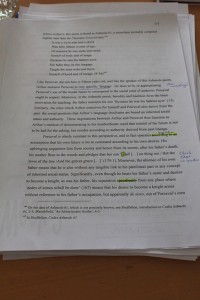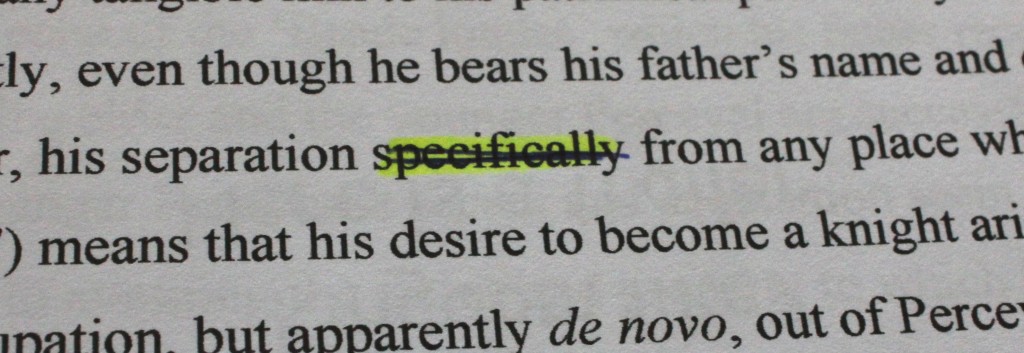 Here I am, taking a coffee break in the midst of my first round of thesis proofreading. I wanted to discuss something I mentioned a long time ago, namely how I’ve been trying to implement some new strategies for organising my PhD work, based on the book Getting Things Done. I’ve discussed this book at length already in relation to managing general household projects, but not in relation to my thesis. So, since I am in the midst of working using this method today, I thought I would share the day’s work as a case study.
Here I am, taking a coffee break in the midst of my first round of thesis proofreading. I wanted to discuss something I mentioned a long time ago, namely how I’ve been trying to implement some new strategies for organising my PhD work, based on the book Getting Things Done. I’ve discussed this book at length already in relation to managing general household projects, but not in relation to my thesis. So, since I am in the midst of working using this method today, I thought I would share the day’s work as a case study.
The project and the problem
Right now, I have a printed copy of my entire thesis and I’ve already read through it and made annotations on the paper copy. Those annotations obviously represent lots of tasks, but they’re jumbled together in no logical order: small edits of typos, citations needed, information to double-check at the library, or whole sections that need rethinking.
I’ll tell you what would happen if I sat down to work my way through making these changes on a 200-page document. I’d breeze through a couple of easy edits, get stuck on a whole paragraph that needed rewriting and sink into an indecisive depression, decide to fix it later and move onto checking a reference against some notes in my files, meanwhile discover an article I’d photocopied that I realised I needed to re-read, randomly remember to ask my supervisor what an ‘Author’s Declaration’ is and whether I need one…
Not that this wouldn’t work, but it’s hard to complete so many different tasks in the same chunk of time. My fear, when going through the document, would be that if I didn’t tackle an edit immediately, I’d forget to come back and change it. So I would comb through the whole thesis multiple times, each time looking for changes of a certain type, invariably missing some, etc.
Inbox and Processing
What I’ve been doing today is treating the whole document, with my annotations, like an inbox. As I go through it, I’m ‘processing’ items from an inbox, not editing the document.
This means that as I process each annotation, I observe the following rules:
- If the change is a quick one requiring less than 2 minutes of time (which also means no serious decisions) – I do it then
- But if the change will take me longer than that, involving hunting for something, asking a question to someone, finding a reference, rewriting a section or simply thinking and deciding what change to make – I transfer the item onto a list to ensure it is recorded as a task
For example, I find this annotation:
Immediately, in less than 2 minutes, I delete the word ‘specifically’
But on the same page, I find this:
This is a two-pronged note. I need to change the ‘s’ in brackets, which I can quickly do immediately. However, finding this mistake also reminded me that my supervisor had told me about this specific issue (changing capitalisation in quotes) and I need to look through the whole document for instances of this and fix them all. I transfer that task onto a list of things to check systematically throughout the document, using a find a replace function.
On that page, I also find this:
Simply a note to myself that I’m not sure whether I’m misreading or misinterpreting something, and I need to review and think it over. I transfer that task to a list of chapter-by-chapter edits to make. Later, when I’m not bogged down by deleting ‘specifically’, I can re-read that section and think about it. Nor do I have to worry that I’ll forget to come back and do it, because it’s clearly written on a list outside the document itself – I don’t need to hope that I remember to look through the document again page by page.
The point
Has this achieved anything that the straightforward ‘read through and make changes’ method doesn’t? I think it has.
- First of all, making only the simple and quick changes now means that I don’t interrupt the speed of going through the document by trying to make decisions for harder problems. Any serious thinking is deferred for a time when it can be tackled in its own right.
- Ideally, I only have to comb through my annotations once this way, because every change marked is either done when I encounter it, or transferred to an external list. I won’t need to go through the whole document again and again. In other words, my ‘inbox’ will be ’empty’.
- Because I’m not making every change when I encounter it, only the 2-minute ones, I can get through the whole document of annotations in a single day (namely today) and, at the end, have a definitive picture of the work remaining to be done. Everything not already completed will be written on another list: search and replace functions to run, questions to ask my supervisor, items to check at the library. A few pages of lists are much better than a series of unknown tasks still hidden in the margins of the document itself.
Back to work now! I hope this has been helpful for some at least. None of this is rocket science, but I often think that because academic work is ‘intellectual’ I don’t submit it to the same methods of tracking and organising I do for ‘real job’ work. I have found that treating it in a systematic way has really helped manage this final stage of work on my thesis.



